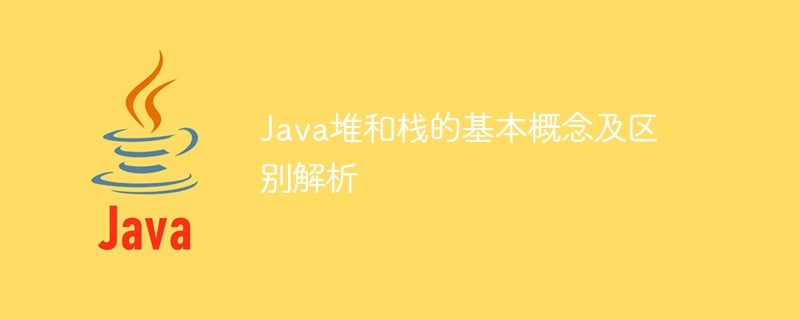

Java heap and stack are two very important concepts in Java programming. They play a vital role in memory management. This article will analyze the basic concepts of Java heap and stack and analyze the differences between them.
First, let us start with the Java heap. The Java heap is the memory area used by the Java virtual machine to store object instances and is the core part of Java memory management. In the Java heap, almost all object instances and arrays are stored in this area. The size of the Java heap is adjusted through the -Xmx and -Xms parameters and can be set as needed.
The Java heap is shared by threads. It is created when the virtual machine starts and is destroyed when it is shut down. It is divided into two parts: the new generation and the old generation. The new generation is mainly used to store newly created objects, while the old generation is used to store objects that have a longer survival time. The purpose of this division is to optimize the object allocation and recycling process. During garbage collection, different collection algorithms and strategies will be used for the new generation and the old generation.
Then, let’s take a look at the Java stack. The Java stack is a memory area used to store local variables and method call information. Each thread creates an independent stack when running to store the method call stack frame. Whenever a method is called, a new stack frame will be created on the stack. The stack frame will contain information such as the parameters of the method, local variables, and intermediate results during the operation. When the method call ends, the corresponding stack frame will be popped and restored to the call point of the previous method.
Unlike the Java heap, the Java stack is thread-private. Each thread has its own Java stack, including stack frames and local variable tables. The stack size is fixed and is set when the virtual machine starts. If there is not enough space on the stack, a StackOverflowError will be thrown. And if there is not enough space in the heap to allocate the object, an OutOfMemoryError error will be thrown.
The most obvious difference between Java heap and stack is their different management methods. The Java heap is automatically managed by the Java virtual machine, and objects are allocated and recycled through the garbage collection mechanism. The Java stack is manually managed by programmers. Programmers need to pay attention to the size of the stack and the life cycle of local variables to avoid stack overflow.
In addition, the memory allocation methods of heap and stack are also different. The Java heap is dynamically allocated and the size of object instances can be determined at runtime. The Java stack is statically allocated, and the size of the stack frame is determined at compile time. This also leads to the fact that objects in the heap can be allocated and released at any location, while local variables in the stack can only be operated on the top of the stack.
In terms of performance, the Java stack is accessed faster than the Java heap. Because access in the stack is through pointers, and access in the heap needs to be through references. In addition, since the Java stack is thread-private, there is no need to consider synchronization and concurrency issues, so in the case of multi-threads, the stack operation will be more efficient than the heap.
To sum up, Java heap and stack are two important concepts in Java memory management. The heap is mainly used to store object instances, which is shared by threads and automatically managed by the virtual machine; the stack is mainly used to store local variables and method call information, which is private to threads and requires manual management by programmers. The difference between heap and stack is reflected in the management method, memory allocation method and performance. Understanding and mastering the characteristics of the heap and stack will help you write more efficient and safer Java programs.
The above is the detailed content of Analyze the basic concepts and differences between Java heap and stack. For more information, please follow other related articles on the PHP Chinese website!
 How to enable secondary logon service
How to enable secondary logon service
 How to turn on Word safe mode
How to turn on Word safe mode
 js method to intercept string
js method to intercept string
 What is the encoding used inside a computer to process data and instructions?
What is the encoding used inside a computer to process data and instructions?
 Introduction to the usage of stickline function
Introduction to the usage of stickline function
 Introduction to the meaning of cloud download windows
Introduction to the meaning of cloud download windows
 How to solve the problem that the msxml6.dll file is missing
How to solve the problem that the msxml6.dll file is missing
 The role of linux operating system
The role of linux operating system




